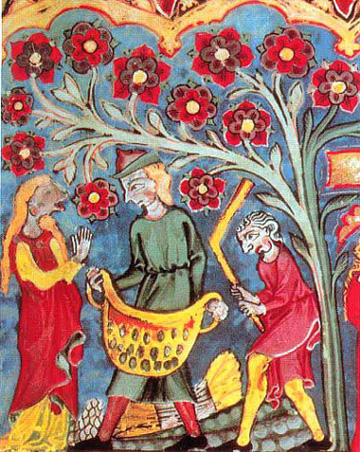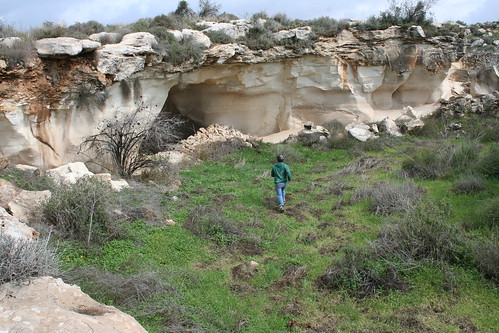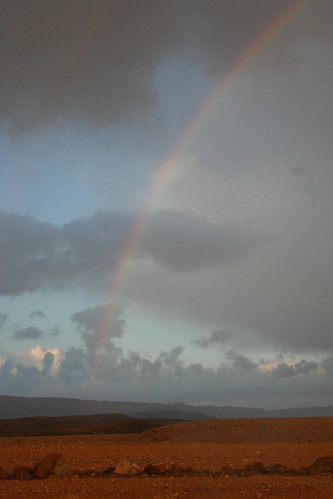
I would be remiss if I did not take the period approaching Passover to address the best known Jewish birds since the dove and the raven of Noah. I am talking about those grotesque, playful half-bird, half-Jew illustrations in what is known as the Bird's Head Haggadah. I went to a talk on Shabbat by David Golinkin about illustrated Haggadahs. (The haggadah is the book which lays out all the rituals and stories of Passover and has been the focus of a lot of Jewish artistic energy over hundreds of years.) He spoke about, among others, the Bird's Head Haggadah which is visually fascinating both
 because it is so lively and also because it is so weird. It is the only Haggadah which depicts human beings with non-human, specifically, bird heads. Balanced on top of their little bearded bird heads are Jew's hats. (In Medieval times, principally in Europe, Jews were often required by law to wear distinctive clothing, the Jewish star being only one example). They caper, they play, they get bake matzah. They generally look pretty happy about being redeemed from bondage. The Bird's Head Haggadah is dated to 13th century Germany. It is -- as far as I understand -- the only illuminated Haggadah from that place and period -- so it is a little hard to know how typical the whole bird thing was of those Haggadahs. It is however the only surviving Medieval haggadah which uses the bird's head device.
because it is so lively and also because it is so weird. It is the only Haggadah which depicts human beings with non-human, specifically, bird heads. Balanced on top of their little bearded bird heads are Jew's hats. (In Medieval times, principally in Europe, Jews were often required by law to wear distinctive clothing, the Jewish star being only one example). They caper, they play, they get bake matzah. They generally look pretty happy about being redeemed from bondage. The Bird's Head Haggadah is dated to 13th century Germany. It is -- as far as I understand -- the only illuminated Haggadah from that place and period -- so it is a little hard to know how typical the whole bird thing was of those Haggadahs. It is however the only surviving Medieval haggadah which uses the bird's head device.So why'd they do it?
The standard explanation was that some zealot had the idea that it was not okay to draw the human face, especially in a religious context, because of the second commandment. There are a number of problems with this theory. For one, there ARE human faces in the Bird's Head Haggadah. The Egyptians, it seems were drawn with human faces, just not the Jews. Second, Jews had a long-established tradition of drawing human faces by the 13th C. and nobody ever seemed to mind before, so why all of a sudden get picky? Third, is it so much better to draw a bird than a human? If the concern is idolatry, certainly idolatry to a bird-headed idol is about as bad as idolatry to a human-headed idol?
Theory two. "They will soar on wings of eagles..." says the prophet Isaiah (40:31).
 The illustrator is making a visual quotation appropriate to the idea of God redeeming the Jewish people. This is possible, but -- and this I did not know before -- there were other illustrated Jewish books from the period of German Jewry which also have humans depicted with animal and bird faces in a variety of contexts; apparently there was a little boom in animal headed humans in German Jewish art of the 13th Century! These have no apparent correlation to the animal's Biblical iconography. What is known as the Ambrosian Bible has a picture of a variety of were-humans enjoying the Feast of the Righteous at the End of Days where God serves up the Leviathan and other mythical menu items. (The picture reminds me of those creepy cartoon advertisements of pigs happily eating hot-dogs). And something called the Tripartite Machzor has all the WOMEN depicted as animals (The illustration is of Catwoman Ruth talking to human headed Boaz). Curiouser and curiouser.
The illustrator is making a visual quotation appropriate to the idea of God redeeming the Jewish people. This is possible, but -- and this I did not know before -- there were other illustrated Jewish books from the period of German Jewry which also have humans depicted with animal and bird faces in a variety of contexts; apparently there was a little boom in animal headed humans in German Jewish art of the 13th Century! These have no apparent correlation to the animal's Biblical iconography. What is known as the Ambrosian Bible has a picture of a variety of were-humans enjoying the Feast of the Righteous at the End of Days where God serves up the Leviathan and other mythical menu items. (The picture reminds me of those creepy cartoon advertisements of pigs happily eating hot-dogs). And something called the Tripartite Machzor has all the WOMEN depicted as animals (The illustration is of Catwoman Ruth talking to human headed Boaz). Curiouser and curiouser.Theory three. It was magic. A fellow named Moshe Carmilly-Weinberger (and David Golinkin agreed with him) argued that the half-human half-animal motif is evidence
 of some kind of magic. It is unclear to me from reading the article whether the magic is being depicted in the illustrations (ie. at the time the Jews were taken out of Egypt the world was transformed and the Jew's odd appearance as birds at the time is a manifestation of that. An obvious problem with this theory is that the Jews in the Bird's Head Haggadah, like most haggadahs, are not all depicted at the time of leaving Egypt, but, as the illustration above shows, are also doing contemporary Passover stuff; baking Matzah). Or the illustrations themselves are supposed to have some magical property to them (ie. having a Haggadah with these half-Jew half-bird creatures in them will protect you against the evil eye or some other force subject to supernatural control). Or both.
of some kind of magic. It is unclear to me from reading the article whether the magic is being depicted in the illustrations (ie. at the time the Jews were taken out of Egypt the world was transformed and the Jew's odd appearance as birds at the time is a manifestation of that. An obvious problem with this theory is that the Jews in the Bird's Head Haggadah, like most haggadahs, are not all depicted at the time of leaving Egypt, but, as the illustration above shows, are also doing contemporary Passover stuff; baking Matzah). Or the illustrations themselves are supposed to have some magical property to them (ie. having a Haggadah with these half-Jew half-bird creatures in them will protect you against the evil eye or some other force subject to supernatural control). Or both.Another explanation, which makes about as much sense as these three that I haven't seen anyone else put forward, is that there were a lot of bird- and animal-headed people walking around Germany in the 13th Century, so the illustrators were just drawing what they saw. Then it got better.
Whatever the Why of it, the birds heads show a healthy Medieval delight in the grotesque and bizarre. More than that, I always get a kick out of those images of the bird-Jew with his Jew hat which suggest to me a kuntz, a playful messing with the Medieval non-Jewish depiction of Jews as supernatural, uncanny, humans-but-not-quite, like he could have a thought bubble over his head saying, "If that's the state of humanity, I think I'd rather stay a bird, thanks."











